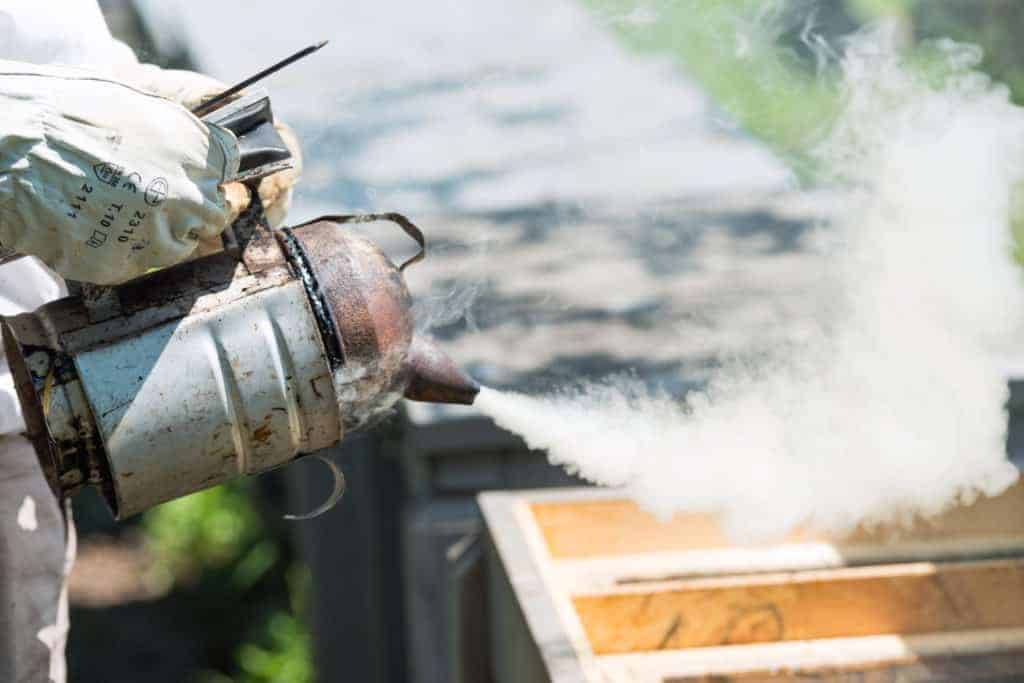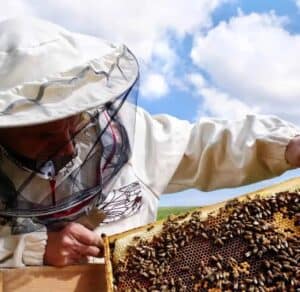How Often Do You Get Stung Beekeeping? How Much Does It Hurt?
Every time a beekeeper goes to collect honey from their hives, they’re directly exposing themselves to thousands of bees at a time. However, that doesn’t mean that beekeepers are being stung repeatedly whenever they’re around their hives.
So, how often do you get stung beekeeping? Most beekeepers will only be stung a handful of times every year. That’s because a skilled beekeeper understands how to move calmly around their hives while using a bee smoker to prevent swarms and attacks. Proper use of bee suits, masks, and gloves also help to keep bee stings at a minimum.
Unless you’re a beekeeper yourself, you might be wondering how a beekeeper can avoid getting stung as often as you might assume. So, we’re going to be explaining why bees sting in the first place, how beekeepers limit instances of being stung, and the importance of protective gear.
Why Bees Sting In the First Place

Though a lot of people are terrified of bees, honeybees are perhaps the gentlest species of bees out there. They’re simply looking to pollinate plants and flowers, create honey, and go about their lives like usual. Honeybees won’t swarm or attack for no logical reason.
Honeybees usually sting when they feel threatened or if they’re in a sort of defense mode. A bee might sting if they’re swatted at by a human, if their hive is being terrorized by a swarm of wasps, or if they have no access to food. Most bee stings occur when the bee feels it or its colony is being threatened.
Building Up a Tolerance
There’s no doubt about it; beekeepers definitely get stung by their own bees.
When a beekeeper gets stung, they’re actually helping to build up their tolerance to the stings. The first sting will definitely be painful and memorable, but they slowly become less painful as the stinging becomes a normal part of their lives.
Skilled beekeepers usually get stung less often than a beginner beekeeper might. Yet, when they do get stung, they understand that it’s just a part of the job (or hobby) and don’t react as they once did.
The biggest issue with getting stung frequently is the potential presence of a bee sting allergy. A beekeeper that’s allergic to bees will always need to have an epi-pen on hand and take extra precautions to avoid angering the bees in their hive.
The Frequency of Stings
A brand new beekeeper might get stung several times a week. That’s likely because they’re using jerky movements around the hive or even swatting bees out of their face when they begin to swarm. They’re causing fear within the bees without even knowing it.
With more time as a beekeeper, the frequency of stinging greatly decreases because the keeper feels more comfortable. Skilled beekeepers usually only get stung a few times per year, and usually because they make a minor mistake.
In all honesty, 5 to 10 bee stings a year is on the upper end. Anything more than this is probably caused by a freak accident of some sort.
How Beekeepers Avoid Getting Stung

Beekeepers avoid getting stung so often because they use their tools and skills to their advantage.
They understand how to move slowly and calmly around the hive, and they use a bee smoker to keep the bees calm during honey retrieval.
Beekeepers also use protective gear to limit the number of stings. Let’s go over exactly what a beekeeper will do to keep their yearly stings low!
The Role of Bee Smokers

A bee smoker is essentially a metal can that a beekeeper starts a fire in. They then use the can to produce gentle billows of smoke that they angle toward the hives before entering. The smoke that comes from a bee smoker is not normally hot or dangerous to the bees.
The reason beekeepers use a bee smoker is to keep the hive calm. When a bee feels threatened, they’ll release pheromones into the air that send other bees into a state of high alert. The smoke from a bee smoker blocks the release of these pheromones and limits the risk of a swarm or attack.
Most beekeepers will use their bee smoker as soon as they begin working with their bees. It’s usually used as a precaution to prevent swarms, even if none of the bees in the hive actually feel threatened by their keeper.
And for more information about the types of fuel to use in your smoker I wrote an article all about the 12 best fuels to use in your beehive smoker I encourage you to read!
Behaving Around a Hive

A good beekeeper isn’t afraid of bees. This lack of fear greatly reduces the risk of getting stung with more experience. And, it’s not because bees can sense fear.
Here are a few tips on how to behave around a beehive:
- Use gentle movements. When you approach a beehive with jerky or rigid movements, you might actually be making the bees a little defensive. With calm and gentle movements, you can reduce this fear amongst your hives and keep your bees calm.
- Operate in good weather. Just like humans, there are certain weather conditions that bees prefer. If you’re choosing to collect honey when it’s windy, snowy, or rainy, you might actually be irritating the bees in your hive. This makes them more likely to sting.
- Don’t swat the bees. The natural response when a bee or an insect gets in your face is to swat it away. Since bees view this swatting motion as an attack, you might be instigating without even trying. The best thing you can do is gently blow the bee away.
It definitely takes a decent amount of time for a beekeeper to understand bee behavior and how to act around a hive. But, developing positive interactions between you and your hive will definitely reduce the risk of getting stung frequently.
The Importance of Protective Gear

When you think of a beekeeper, you’re probably picturing the typical white beekeeper suit and the cage-looking mask. These outfits won’t always protect a beekeeper from being stung altogether, but they definitely help.
The key component of the beekeeper ensemble is the standard white beekeeper suit. The reason these suits are white and not other colors is that bees are less likely to approach lighter colors when they’re agitated. Even if you accidentally anger your hive, they’re less likely to swarm you when you’re wearing your suit.
There’s a good reason that a bee suit is used instead of regular clothing: It keeps bees from hiding out in the crevices and openings of your clothes. That’s made possible with elastic around the wrists and ankles of a bee suit, keeping bees from sneaking into your clothing.
Beekeepers also use veils or masks to keep bees from getting too close to their face or neck. Since bees will be kept at a decent distance from the face, this also lessens the chance that a beekeeper will accidentally swat a bee away. The fewer bee stings on the face, the better.
The beekeeper outfit guarantees that all visible skin is covered. Not only are you wearing a suit and a mask, but you’re also covering your hands with gloves and your ankles with boots. The entire goal is to limit the amount of stingable area that you’re exposing to the bees.
For more information about how much protection beekeeping suits offer, I wrote an article about if you still get stung while wearing bee suit I encourage you to read!
Conclusion
Beekeepers spend a lot of time around thousands of bees at once, yet they somehow avoid getting stung quite often. In fact, a majority of beekeepers might only get stung a few times per year, usually no more than ten times.
With time and experience, a beekeeper will understand just what they need to do to avoid getting stung. That includes wearing the proper protective gear, learning how to act properly around a hive, and using a bee smoker to calm their hives.

Joseph Davis
My goal is to show that anyone can take up beekeeping and it can be a very rewarding hobby. I strive to share my experiences and answer any questions you may have.
